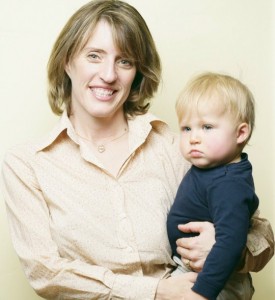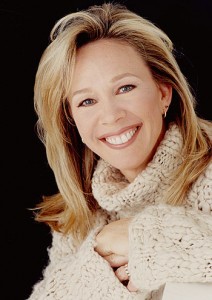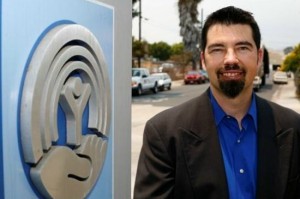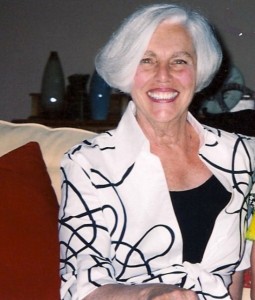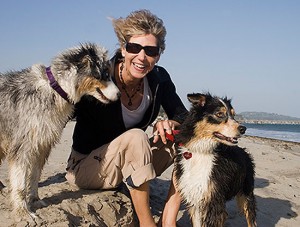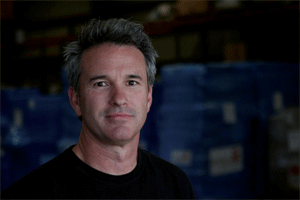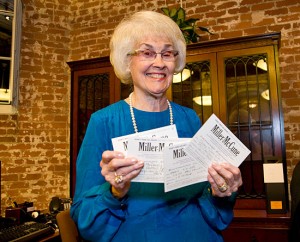
Philanthropist and entrepreneur Sara Miller McCune has taken her passion for public policy and poured it into her newest venture, the Miller-McCune Center for Research, Media & Public Policy and its magazine and Web site. (Helene Glassman photo) (courtesy Noozhawk)
At a time in her life when many people are focused on hitting the links, Sara Miller McCune has instead hit the ground running with her newest venture, the Miller-McCune Center for Research, Media and Public Policy, which produces a magazine and website that meld the worlds of academic research with hard-hitting reporting. It’s a perfect fit for Miller McCune, who also co-founded (with her late husband George McCune) SAGE Publications in 1965, an international publisher of academic journals and textbooks, and the nonprofit McCune Foundation, in 1990, which focuses on social justice issues in Santa Barbara and Ventura Counties.
Leslie Dinaberg: Tell me about your new magazine, Miller-McCune? Where did the idea come from?
Sara Miller McCune: I’ve been thinking about doing it since the 1980s when we started what I call an idea file … then it became two files because we had too many ideas. We actually talked (about a merger) with a couple of magazines over those years … but it didn’t happen.
Finally the SAGE Publications board, after hearing me talk about this dream that I’ve had all these years, just said, “shut up. Here’s x much money, go and start one.” So that’s this all came about.
LD: Congratulations. So you’ve got two issues down?
SMM: Two issues out and another issue in preparation. We’re going to do six this year and then either six or seven. The plan is by the time we’re in year five to do ten issues a year.
LD: Is there some sort of organized synergy with the authors that you work with at SAGE Publications and Miller-McCune Magazine?
SMM: No it’s a disorganized synergy. They really have no responsibility as a SAGE author or a contributor to one of SAGE’s journals, to publish anything in the magazine. It’s more a matter of do they want to be read by 100,000 people and for a lot of social scientists that’s very attractive. For example, this lead article is by the outgoing president of American Academy of Political and Social Science, where he is comparing European policies to American and showing why Europeans are doing better.
LD: What is the target audience for this magazine?
SMM: There are several target audiences: leaders of youth organizations; elected officials, state, local and federal; social scientists who are interested in their research affecting and influencing public policy; public policy workers at all levels, who are interested in using research to make policy, and then they’re not just kind of guessing or experimenting on their own; people who are involved in substantive work; NGOs; philanthropists; and then a certain number of scientists from things like Environmental Studies; there’s an emerging area of interdisciplinary research out at UCSB that is, say at the Sage Center for Study of the Mind, it’s gathering people from all different disciplines. It’s not just neuroscience and it’s not just the classic sense of political science and ethics, it’s a melding of that with people who are interested in language and how it affects people, people who are interested in how the brain works and how that affects the body and affects behavior and then affects the behavior of individuals meshing together into what we call societies.
So the audience keeps getting bigger and bigger from the molecule to ultimately the globe. I have never been very good at science, so I’m not really someone who works with molecules and I don’t think that one person necessarily comes up with solutions to global problems and actually makes those solutions happen. For that you need a collection of linked individuals and I hope this 100,000 eventually becomes, say 500,000 and makes a difference in that–but then I’ll be six under.
I’ve already bought the plot. That’s another story. I had 45 minutes to spare one day.
LD: Where did you go?
SMM: The cemetery that overlooks the ocean, because there wasn’t a Jewish cemetery in town. So I walk in and I say, “I’ve got 45 minutes … Do you have any with a view?”
We get in the golf cart and he takes me to look at two parcels. There was one on the side overlooking the ocean and there was one on the other side of the path where still you could see the ocean but not as well, and the price is $2,000 difference. … So I said, “How come there’s a $2,000 difference when they’re just on different sides of the path but within six feet of each other?” And he said, “Oh well in that one you have an ocean view.” And I said, “I’ll be six feet under, what do I care?”
He says, “Well you can put a little bench in like those people and your children will come and visit you.” I said, “You don’t know my step-kids. Let’s go back to the office and I’ll either buy the one which is cheaper or I’m outa here.” So he made out the paperwork, I wrote the deposit and that’s my lot.
LD: Ocean-view adjacent property.
SMM: Yes, the one that’s across the path from the ocean. (Laughs) With no bench.
LD: Can you tell me about some of your humanitarian work?
SMM: This September, Mollie of Trattoria Mollie and I and a couple of people in Montecito are going to start a school for girls in Africa, which is another place I’ve worked, and I think Direct Relief International is involved in that.
LD: It’s great that you’re doing that.
SMM: Yeah, it’s interesting and I think in time these things can be replicated in other areas. That is a lot of the basis of things that I publish, the boring stuff that is all about evaluation, replication, can we get the same results in different places.
LD: The magazine does seem like a good opportunity to get some of that kind of information into the more general public’s hands.
SMM: You’re right. That’s the whole purpose of it.
…The print magazine has a slightly different character than the website partly because Michael Todd (editor of the website) and John Mecklin (editor of the magazine) are very different and their networks are different and the things that people are interested in are different, and also, of course, the deadlines are enormously different between having six issues in print a year and going five times a week online.
LD: I know at one point you were interested in purchasing the Santa Barbara News-Press, is that still an interest?
SMM: Well, I think that A, I never got an answer, and B, they are involved in a lawsuit which is going to run for several more years, according to something I was reading in the papers. I’ve never been a big fan of publishers trying to settle things by litigation. I think it’s a waste of subscription money and that’s other people’s money, whether it’s advertiser’s money or subscriber’s money, it’s other people’s money. Now I think you know Wendy has enough money that she may choose to spend on litigation but I’ve never felt that that was a good use of my resources…
And in the meantime the community suffers, and this is a great community. I don’t like to see a community as terrific as ours being punished by this sort of thing, so that’s another reason I said I would buy it. But there was no answer, there’s obviously no interest there. There must be other items on the agenda. I don’t think it’s going anywhere and I’ve got other fish to fry.
We only have so many years on this earth and my stepson has a saying that money is a renewable resource, time is not. And as a breast cancer survivor I agree with him.
LD: What else do you do when you’re not working?
SMM: I love going to the theatre and I love reading. I always make sure I have at least 40 unread books within reach of whatever bed I am in.
LD: A woman after my heart.
SMM: Because there is a chance that I might get up at 2 a.m. and the bookstore won’t be open and I will be frantic. And have nothing to read. We cannot allow this to happen. And even a pile of unread New York Times that always seem to be around will not do at 2 a.m. It has to be a mystery or it has to be a biography of somebody that I really, really, really like. Or it has to be some kind of bodice ripper or something.
…Then, in more normal hours I take people to the theatre. I like plays, I like opera, I like musical comedies, and I like farces. The more farcical, the more I laugh. I love Shakespeare when it’s performed well, so usually I see that in either London or Oxford.
LD: How much of your time do you spend in Santa Barbara?
SMM: I would say at least half.
LD: How did you end up coming to live in Santa Barbara?
SMM: I was widowed 1990, and George and I had always loved to come to Santa Barbara to work and still have a lot of authors and friends on the faculty at UCSB. I am, in fact, on the USCB Foundation and have been since around 1993, and I’ve given money and we still have a lot of authors at UCSB, it’s a very good school, it just keeps improving.
I was having a New Year’s Eve dinner with three faculty couples … and we must have worked our way through a lot of champagne, a lot of champagne, and so we were making our New Year’s toasts as 1992 became 1993 and the words just came out of my mouth, I didn’t expect them to. But I said, “by this time at the end of the year I’m going to be living here,” and then we had more champagne. That May I started looking for a house and by August I had one. And then I had 103 boxes of books in my living room…If I moved again, which I’m not going to, it would be 200 boxes.
LD: If you could be invisible anywhere in Santa Barbara, where would you go and what would you do?
SMM: That’s a weird question. Do you ask everybody that?
LD: I do actually.
SMM: I don’t like spying on people. I don’t do it. I mean I’m either there visibly and vocally or I’m not there at all.
Vital Stats: Sara Miller McCune
Born: Manhattan, February 4th
Family: Widowed in 1990, husband was publisher George McCune. Stepmother to four grown children, four grandchildren and two great grandsons “so far.”
Civic Involvement: President of the nonprofit McCune Foundation; President of the nonprofit Miller-McCune Center for Research, Media and Public Policy; UCSB Foundation; Granada Theatre Restoration Project; Santa Barbara Center for the Performing Arts; American Academy of Political and Social Science; Lifetime Fellow, Fielding Graduate Institute.
Professional Accomplishments: Founder and Executive Chair of SAGE Publications, a leading international publisher of academic journals and textbooks with more than 800 employees in the United States, New Deli, Singapore and London.
Favorite Book: Collected Plays of Shakespeare
Little-Known Fact: “I was once the star of an off, off Broadway production, when I was a teenager. It was based on a book by Henry James called The Innocents. Instead of the lead being the brother Miles, the role was Millicent, and that was me. I got to be really mean and nasty although on the outside I was all good.”
Originally published on Noozhawk on May 10, 2008.

